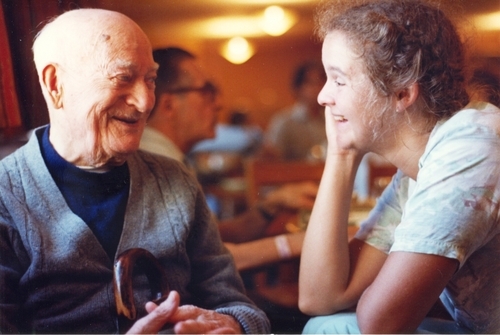Morres, Stephen E. E.: my Army recollections (June 12, and 19, 1979)
Rank: Brigadier.
ABSTRACT: Brigadier Stephen E.E. Morres Royal Canadian Horse Artillery Royal Canadian Artillery Morres_S_0108_01.mp3 (Side 1) Born on Sept. 4, 1907 in Plymouth, Eng. His father was one of the Royal Navy officers aboard H.M.C.S. Niobe in 1910 when she was acquired by the Royal Canadian Navy. Sent to prep school in England, then Shawnigan Lake School on Vancouver Island in 1920. Entered the Royal Military College in Sept. 1924. Describes the strict discipline, uniforms, senior cadet ranks, barrack conditions, fees, etc. (10:00) For two summers he was involved in the provisional pilot officer training program of the R.C.A.F. at Camp Borden. Preferred horses to aircraft and upon graduation from R.M.C. in 1928 was accepted into the Royal Canadian Horse Artillery as a lieutenant. (25:00) A lieutenant was paid four dollars per day of which one dollar was deducted for extra messing. Uniforms, obtained through the regimental tailors, Hawkes of No. 1 Bond St., London, were a major expense. A comfortable life in the officers' mess in Kingston: a batman looked after his clothes and a groom looked after his horse. Dressed for dinner four times a week. Thursdays were guest nights with the regimental band in attendance. Once a month all officers "dined in". No government furniture or equipment; all belonged to the regiment. Comments on the composition of a horse artillery battery. As a section (troop) commander he was responsible for training both horses and men. At the beginning of the depression they obtained Leyland and Crossley trucks from England and lost their horses. Very short of ammunition during this period. Militia batteries were allowed five rounds per gun for summer training at Petawawa. (40:00) As a captain he was sent to Woolwich, Eng. on an advanced gunnery course, finishing at Christmas 1939. (45:00) Morres_S_0108_02.mp3 Returned to Canada in Apr. 1940. Posted to Ottawa for nearly a year. Returned to England after working with Maj.-Gen. F.F. Worthington on the armament of the Canadian-built Ram tank. A member of the Ordnance Board. Appointed Director of Artillery in Ottawa in the rank of colonel. In order to proceed overseas again he reverted to lieutenant-colonel and in late 1943 was appointed to the weapons technical staff at 21 Army Group. Anecdote re anti-aircraft guns on Mulberry harbours. His duty was to see that weapons systems worked correctly and to this end the staff could circumvent all normal government or military channels and deal directly with the manufacturers if modifications to equipment were necessary. Describes some problems: premature explosions in twenty-five pounder guns, fuse problems with 5.5-in. medium artillery shells, etc. (27:00) Morres_S_0108_03.mp3 (Side 2) Went to Normandy toward the end of June 1944 to a British headquarters as an artillery equipment specialist. Later, as part of 21 Army Group H.Q., he visited all artillery units in France, Belgium, and Holland. Still had direct access to the Ministry of Supply for design or manufacturing change. At the end of the war he was posted to the Experimental Establishment in England. Returns to an interesting account of experiences with the Dutch underground the day before the war ended. Posted to Ottawa in late 1946. Colonel on the Joint Staff in London. In Canada promoted to brigadier and was concerned with design and development for the army as a whole. (20:00) N.A.T.O. standardization problems were very frustrating. Formed the opinion that the Americans objected a great deal. The problem with Canadian development was usually financial. Morres_S_0108_04.mp3 In 1957 was appointed area commander in Newfoundland. Unification and integration caused much disruption in the services, although least in the air force. Canadian Forces today entirely different; discipline probably easier. Equipment nowadays is extremely expensive to purchase and maintain. (44:00)
Interviewee: Morres, Stephen E. E., b. 1907
Interviewer: Main, Chris D.
An interview/narrative of Stephen E. E. Morres's experiences during World War II. Brigadier Morres served with the Royal Canadian Horse Artillery and the Royal Canadian Artillery. Interview took place on June 12 and 19, 1979.
- In Collection:
- 4 sound recordings (MP3)
- 46, 2
- 52.16045, -0.70312
- One original sound tape reel (ca. 120 min.) : 1 7/8 ips, 2 track, mono. ; 2 sound cassette copies : standard, mono. in Special Collections.
- Canadian Military Oral History Collection
- MSEE_108
- Special Collections Finding Aid: https://search.archives.uvic.ca/reginald-herbert-roy-fonds
- July 12, 2007
- Digital sound recording in .wav format at 16 bits and 22 kHz. In .mp3 format at 64 kbps and 22 kHz. Digitized by AN, technical and cataloguing metadata provided by JF and JP. Transferred from audio reel to audio cassette between 1987-1997. Interview migrated to digital format for UVic Special Collections in 2007. Migration metadata by KD and MT.
- Rights
- This interview has been posted with the understanding that it may be used for research purposes only. Should the interviewee or their heirs have any objections to this interview being accessible on the Internet, it will be removed promptly. Contact UVic Special Collections for permission if using for other than research purposes: speccoll@uvic.ca
- DOI
| Thumbnail | Title | Date Uploaded | Actions |
|---|---|---|---|
|
|
SC141_MilitaryOralHistory_GenericThumbnail |
|
|

|
Morres_S_0108_01.mp3 |
|
|

|
Morres_S_0108_02.mp3 |
|
|

|
Morres_S_0108_03.mp3 |
|
|

|
Morres_S_0108_04.mp3 |
|